|
|
|
|
|
Oil On
Canvas, Real Flavor of Old Masters
|
|

|
ARTWORKS
INDEX
A B C D E F G H I J K L M N O P Q R S T U V W X Y Z |
ARTISTS
INDEX
A B C D E F G H I J K L M N O P Q R S T U V W X Y Z |
|
|
| | |
|
|
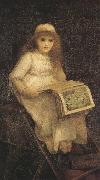 |
charles edward halle -- Click Here
|
|
French painter, born in 1846 and died in 1919 |
|
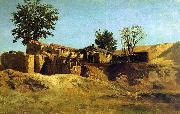 |
Carlos de Haes -- Click Here
|
|
Spanish
1826-1898
Carlos de Haes Galleries
Spanish painter of Belgian birth. In 1835 he moved with his parents to M?laga, where he studied under the court portrait painter and miniature painter Luis de la Cruz y R?os (1776-1853). In 1850 he returned to Belgium and studied with the landscape painter Joseph Quineaux (1822-95). During his studies there and on his travels in France, Germany and Holland, he became acquainted with contemporary Realist trends. He returned to Spain in 1855, becoming a naturalized Spaniard, and the following year he exhibited numerous landscapes at the Exposici?n Nacional, Madrid, to much acclaim. In 1857 he won the competition for the fourth chair of landscape painting at the Escuela de Bellas Artes in Madrid with View of the Royal Palace from the Casa de Campo (1857; Madrid, Real Acad. S Fernando), a work showing characteristics of the Barbizon and Fontainebleau landscape schools. In 1860 he was elected Acad?mico de m?rito at the Real Academia de S Fernando in Madrid. By 1861 he was officiating and drawing up the regulations for the landscape competitions for aspiring pensionnaires. Consequently plein-air works came to be required in place of the previous tradition of submitting historical landscapes executed in the studio, a practice that discouraged the study of nature. De Haes suggested that only final corrections should be made in the studio, an attitude that indicates his timid initiation and acceptance of Realist trends. |
|
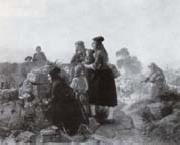 |
Carl Hubner -- Click Here
|
|
1814-1879, was a German genre painter. He was born at Konigsberg, and was a pupil of the Dusseldorf Academy. Hubner's works were especially popular in Holland and in North America, where he was received with enthusiasm in 1874. |
|
|
|
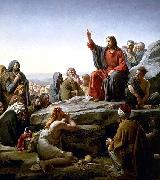 |
Carl Heinrich Bloch -- Click Here
|
|
(May 23, 1834 C February 22, 1890) was a Danish painter.
He was born in Copenhagen and studied with Wilhelm Marstrand at the Royal Danish Academy of Art (Det Kongelige Danske Kunstakademi) there.
His early work featured rural scenes from everyday life. From 1859 to 1866, Bloch lived in Italy, and this period was important for the development of his historical style.
His first great success was the exhibition of his "Prometheus Unbound" in Copenhagen in 1865. After the death of Marstrand, he finished the decoration of the ceremonial hall at the University of Copenhagen.
He was then commissioned to produce 23 paintings for the Chapel at Frederiksborg Palace. These were all scenes from the life of Christ which have become very popular as illustrations. The originals, painted between 1865 and 1879, are still at Frederiksborg Palace. |
|
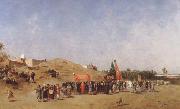 |
Carl Haag -- Click Here
|
|
1820 - 1915
German painter, active in Britain. After studying in Nuremberg, he painted miniature portraits in Munich and Brussels. In 1847 he went to London to study English techniques of watercolour painting and evolved a method that he claimed achieved the 'brilliancy of oil painting, combined with the tender-sweetness of water-colours' . From 1850 he exhibited at the Society of Painters in Water-Colours and was elected a full member in 1853. |
|
|
|
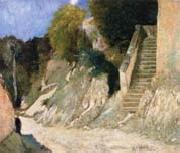 |
Carl Fredrik Hill -- Click Here
|
|
Swedish Painter, 1849-1911,Swedish painter and draughtsman. He grew up in the university city of Lund, where his father was a mathematics professor. Despite severe opposition from his father, he studied landscape painting at the Konstakademi in Stockholm (1871-2), under Johan Edvard Bergh and Per Daniel Holm (1835-1903). He also frequently copied Dutch Old Masters, particularly Jacob van Ruisdael. After seeing the work that Alfred Wahlberg had sent home from Paris, Hill began to abandon his initial approach to form and colour, and he left for Paris in November 1873. His most important experience there was his encounter with the painting of Jean-Baptiste-Camille Corot: 'Corot has discovered a new world, because he has discovered a new way of looking at the old', he wrote in a letter. Other contemporary French painters Hill admired were Alexandre-Gabriel Decamps, Charles-Fran?ois Daubigny, Jean-Franeois Millet and Theodore Rousseau. From Courbet he learnt how to use colour to suggest the surface texture of stone quarries and gravel hills. In Barbizon in 1874 and 1875 Hill met the Hungarian painters Laszlo Pael and Mihaly von Muncacsy. His paintings of this time, for example Autumn Landscape, Evening: Fontainebleau (1875; Malm?, Kstmus.), are characterized by their dark 'luminarism' and their debt to Corot's later works. |
|
|
|
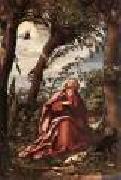 |
BURGKMAIR, Hans -- Click Here
|
|
German Northern Renaissance Painter, 1473-1531
German artist, famous for his paintings and woodcuts. A friend of D??rer, he studied in Strasburg and Venice, as well as Augsburg. He executed the woodcuts for Weißkunig and some of those in Teuerdank. His greatest works are the altar-pieces in Munich and Augsburg. |
|
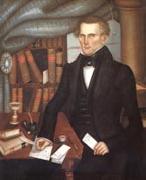 |
Bundy Horace -- Click Here
|
|
American portraits and landscapes painter, 1814-1883 |
|
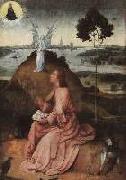 |
BOSCH, Hieronymus -- Click Here
|
|
Netherlandish Northern Renaissance Painter, ca.1450-1516
Bosch produced several triptychs. Among his most famous is The Garden of Earthly Delights. This painting depicts paradise with Adam and Eve and many wondrous animals on the left panel, the earthly delights with numerous nude figures and tremendous fruit and birds on the middle panel, and hell with depictions of fantastic punishments of the various types of sinners on the right panel. When the exterior panels are closed the viewer can see, painted in grisaille, God creating the Earth. These paintings have a rough surface from the application of paint; this contrasts with the traditional Flemish style of paintings, where the smooth surface attempts to hide the fact that the painting is man-made.
Bosch never dated his paintings and may have signed only some of them (other signatures are certainly not his). Fewer than 25 paintings remain today that can be attributed to him. Philip II of Spain acquired many of Bosch's paintings after the painter's death; as a result, the Prado Museum in Madrid now owns several of his works, including The Garden of Earthly Delights.
|
|
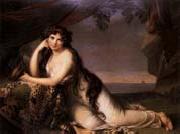 |
BONE, Henry -- Click Here
|
|
British, 1755-1834,Cornish enamel painter, was born at Truro. He was much employed by London jewellers for small designs in enamel, before his merits as an artist were well known to the public. In 1800 the beauty of his pieces attracted the notice of the Royal Academy, of which he was then admitted as an associate; in 1811 he was made an academician. Up to 1831 he executed many beautiful miniature pieces of much larger size than had been attempted before in England; among these his eighty-five portraits of the time of Queen Elizabeth, of different sizes, from 5 by 4 to 13 by 8 in. are most admired. They were disposed of by public sale after his death. His Bacchus and Ariadne, after Titian, painted on a plate, brought the great price of 2200 guineas. He had 2 sons, who were also notable enamallists: Henry Pierce Bone & Robert Trewick Bone. |
|
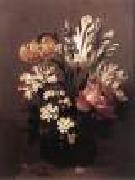 |
BOLLONGIER, Hans -- Click Here
|
|
Dutch painter, Haarlem school (b. ca. 1600, Haarlem, d. ca. 1675, Haarlem)
Hans Gillisz. Bollongier or Boulenger (Haarlem, 1600-idem, 1645) was a still life Dutch painter. |
|
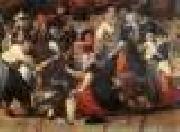 |
BOL, Hans -- Click Here
|
|
Flemish Northern Renaissance Painter, 1534-1593
Hans Bol (1534?C1593), Flemish artist, received his early training from his two uncles who were also painters. He then was the apprentice to a Mechelen watercolorist and tempera painter at the age of fourteen. Because Bol??s watercolors became so widely reproduced, he began creating miniatures on parchment. The technique earned him many international clients and a good income. In addition, Bol also produced several oil paintings, illuminated manuscripts, drawings, and engravings. He preferred to create landscapes, mythological, allegorical and biblical scenes, and genre paintings. |
|
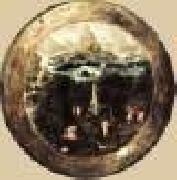 |
BLES, Herri met de -- Click Here
|
|
Flemish Northern Renaissance Painter, ca.1510-1550
Flemish painter. Both van Mander and Lampsonius recorded Bouvines as his birthplace, although Guicciardini gave it as Dinant. The identification of Herri met de Bles with Herry de Patinir, who was a master of the Antwerp Guild of St Luke in 1535, is generally accepted. He may have been related to Joachim Patinir, possibly a nephew. In the Pictorum aliquot celebrium Germaniae Inferioris effigies (Antwerp, 1572) of Domenicus Lampsonius, Henricus Blesius Bovinati pictori is portrayed aged 40, sporting the type of clothing and beard that were fashionable in 1550. |
|
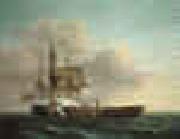 |
Birch, Thomas -- Click Here
|
|
English-born American Painter, 1779-1851
American painter of English birth. He was one of the most important American landscape and marine painters of the early 19th century. He moved to America in 1794 with his father William Birch (1755-1834), a painter and engraver from whom he received his artistic training. The family settled in Philadelphia, where William, armed with letters of introduction from Benjamin West to leading citizens of that city, became a drawing-master. Early in their American careers both Birches executed cityscapes, several of which were engraved. Thomas contributed a number of compositions to The City of Philadelphia in the State of Pennsylvania, North America, as it Appeared in the Year 1800 (1800), a series of views conceived by the elder Birch in obvious imitation of comparable British productions. An English sensibility is also apparent in the many paintings of country estates executed by father and son in the early 19th century These compositions, along with such portrayals of important public edifices in and near Philadelphia as Fairmount Waterworks |
|
|
|
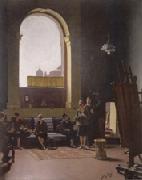 |
Bernard Hall -- Click Here
|
|
Artist, teacher, Director of Melbourne??s National Gallery and Felton Bequest advisor
English-born Australian, 1859-1935
was an English-born Australian artist. Hall was born at Liverpool, England. The son of a Liverpool broker of the same family as Captain Basil Hall, writer of books of travel, he was well educated and grew up in an atmosphere of culture. He studied painting at South Kensington, Antwerp and Munich, and worked for some to years in London. He exhibited at the Royal Academy and was one of the original members of the New English Art Club. On the death of George Frederick Folingsby in 1891 he was appointed director of the National Gallery of Victoria at Melbourne, and began his duties in March 1892. He held the position for 43 years aria many of the well-known painters of Australia were trained by him in the gallery painting school. He also acted as adviser to the trustees for purchases for the gallery and art museum, and when the munificent bequest of Alfred Felton was received his responsibilities were much increased. In 1905 he went to England to make purchases under this bequest, and although the amount then placed in his hands was comparatively small, he made better use of what was available than any subsequent adviser of his time. After his return he was expected to advise on everything submitted that might find a place in an art museum and, although he never claimed to be an expert in all these things, he supplemented his knowledge with hard reading and made cornparatively few mistakes. Hall's own paintings were usually interiors, nudes, or paintings of still life. He was often represented at the Victorian Artists' and other societies' exhibitions and held several one-man shows, but he was kept so busily employed as director and adviser, that his paintings had to be done at week ends and during vacations. In February 1934 he again went to London as adviser to the Felton trustees and died there on 14 February 1935. He was married twice in 1894 to Miss E. M. Shuter and in 1912 to Miss G. H. Thomson, who with one son by the first marriage and two sons and a daughter by the second marriage, survived him. Hall was a tall man of distinguished appearance, courteous but slightly austere in manner, with strong convictions, and little sense of compromise. He was extremely conservative in almost everything from his art to his politics. |
|
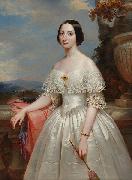 |
Benoit Hermogaste Molin -- Click Here
|
|
painted Painting of Maria Adelaide, wife of Victor Emmanuel II, King of Italy in 1848 |
|
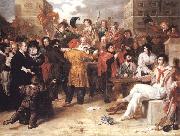 |
Benjamin Robert Haydon -- Click Here
|
|
English Romantic Painter, 1786-1846
1786-1846.was an English historical painter and writer. Haydon was born at Plymouth. His mother was the daughter of the Rev. Benjamin Cobley, rector of Dodbrooke, near Kingsbridge, Devon. Her brother, General Sir Thomas Cobley, was renowned for his part in the siege of Ismail. Benjamin's father, a prosperous printer, stationer and publisher, was well known in Plymouth. Haydon, an only son, at an early date showed an aptitude for study, which was carefully fostered by his mother. At the age of six he was placed in Plymouth grammar school, and at twelve in Plympton St Mary School, the same school where Sir Joshua Reynolds had received most of his education. On the ceiling of the school-room was a sketch by Reynolds in burnt cork, which Haydon loved to sit and look at. Whilst at school he had some thought of adopting the medical profession, but he was so shocked at the sight of an operation that he gave up the idea. Reading Albinus inspired him with a love for anatomy; but from childhood he had wanted to become a painter. Full of energy and hope, he left home, on 14 May 1804, for London, and entered the Royal Academy as a student. He was so enthusiastic that Henry Fuseli asked when he ever found time to eat. Aged twenty-one (1807) Haydon exhibited, for the first time, at the Royal Academy, The Repose in Egypt, which was bought by Thomas Hope the year after for the Egyptian Room at his townhouse in Duchess Street. This was a good start for the young artist, who shortly received a commission from Lord Mulgrave and an introduction to Sir George Beaumont. In 1809 he finished his well-known picture of Dentatus, which, though it increased his fame, resulted in a lifelong quarrel with the Royal Academy, whose committee had hung it in a small side-room instead of the great hall. That same year, he took on his first pupil, Charles Lock Eastlake, later destined to become one of the great figures of the British art establishment. In 1810 his financial difficulties began when the allowance of £200 a year from his father was stopped. His disappointment was embittered by the controversies in which he now became involved with Beaumont, for whom he had painted his picture of Macbeth, and Richard Payne Knight, who had denied the beauties as well as the money value of the Elgin Marbles. |
|
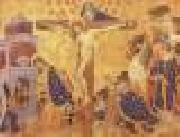 |
BELLE-CHOSE, Henri -- Click Here
|
|
Flemish Gothic Era Painter, active ca.1415-1440
South Netherlandish painter. He was one of the artists who came from the South Netherlands to work for the French royal family. On 23 May 1415 he succeeded Jean Malouel as court painter and Valet de Chambre to John the Fearless, Duke of Burgundy, in Dijon, and he may already have been connected with Malouel's workshop. On 5 November 1415 Bellechose was paid for painting four small wooden pillars with angels, which were placed around the high altar of Notre-Dame, Dijon. On 19 May 1416 the duke authorized the purchase of materials for Bellechose to complete two panels, one of the Martyrdom of St Denis and another showing the Death of the Virgin, for the Charterhouse of Champmol. Bellechose also carried out decorative work, including painting banners for the Duke's castle of Talant near Dijon in 1416 and coats of arms for the funeral of John the Fearless in 1419. On 5 April 1420 Bellechose was appointed court painter to Philip the Good, successor to John the Fearless. His first known commissions were again of a decorative nature, including work for the funerals of Margaret of Bavaria, wife of John the Fearless, in 1423 and of Catherine of Burgundy, daughter of an earlier Duke of Burgundy, Philip the Bold, in 1425 and for the marriage of Philip the Good's sister Agnes of Burgundy in 1424. During these years he had eight assistants and two apprentices; travelling artists, including some from German territory, also worked in his shop on a temporary basis. Around this time he married Alixant Lebon, daughter of a Dijon notary. On 21 November 1425 Philip the Good ordered an altarpiece of the Virgin venerated by John the Fearless and Philip the Good, accompanied by SS John the Evangelist and Claude, for the chapel of the castle at Saulx-le-Duc in Burgundy. Bellechose painted three statues for the new entrance gate to the palace in Dijon in 1426. In August 1429 he received an important commission for St Michel, Dijon, to make an altarpiece with Christ and the Twelve Apostles and an antependium showing the Annunciation. Exactly a year later his name appears for the last time in the ducal accounts. |
|
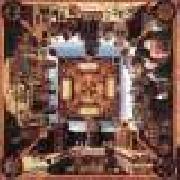 |
BEHAM, Hans Sebald -- Click Here
|
|
German Northern Renaissance Engraver, 1500-1550
Hans Sebald Beham (1500 ?C 1550) was a German printmaker who did his best work as an engraver, and was also a designer of woodcuts and a painter and miniaturist. He is one of the most important of the "Little Masters", the group of German artists making old master prints in the generation after Durer.
Beham is best known as a prolific printmaker, producing approximately 252 engravings, 18 etchings and 1500 woodcuts, including woodcut book illustrations. He worked extensively on tiny, highly detailed, engravings, many as small as postage stamps, placing him in the German printmaking school known as the "Little Masters" from the size of their prints. These works he produced and published himself, whilst his much larger woodcuts were mostly commissioned work. The engravings found a ready market among German bourgeois collectors, but were not much seen in Italy. He also made prints for use as playing cards, wallpaper, coats of arms, and designs for other artists, including many designs for stained or painted glass. He also illuminated two prayer books and painted a table top (now in the Louvre ) for Cardinal Albrecht, Archbishop of Mainz. |
|
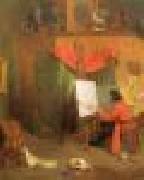 |
Beard, William Holbrook -- Click Here
|
|
American Painter, 1824-1900 |
|
 |
Bartholomeus van der Helst -- Click Here
|
|
1613-1670
Dutch
Bartholomeus Van Der Helst Galleries
Dutch painter. He was the son of a Haarlem inn-keeper and presumably undertook part or all of his training in Amsterdam. His earliest works suggest that the painter Nicolaes Eliasz. Pickenoy was his master. Although van der Helst had probably already established himself as an independent master by the time he married Anna du Pire in Amsterdam in 1636, his earliest known work, a portrait of The Regents of the Walloon Orphanage, Amsterdam (Amsterdam, Maison Descartes), dates from 1637. Stylistically it is close to the work of Pickenoy. His portrait of a Protestant Minister of 1638 (Rotterdam, Boymans-van Beuningen) reveals the influence of Rembrandt. The young artist must have risen rapidly to fame in Amsterdam, for as early as 1639 he received the prestigious commission for a large painting for the Kloveniersdoelen (Arquebusiers or Musketeers Hall): The Civic Guard Company of Capt. Roelof Bicker and Lt Jan Michielsz. Blaeuw (Amsterdam, Rijksmus.), which formed part of the same series as Rembrandt Night Watch (Amsterdam, Rijksmus.). Van der Helst may not have completed this commission until 1642 or 1643. The ingenious arrangement of the figures in a broad composition shows the artist special talent for composing large groups. Pickenoy influence is less noticeable here than in the portrait of 1637; the self-assured poses of the individual figures were to become a characteristic feature of van der Helst work. The successful execution of this portrait established van der Helst reputation: from 1642, when he began to receive an increasing number of commissions for individual portraits, until 1670 he was the leading portrait painter of the ruling class in Amsterdam. From 1642 his technique in portrait painting gradually became more fluent and the rendering of costume materials more detailed. Some typical portraits of his earlier period are those of Andries Bicker (Amsterdam, Rijksmus.), his wife Catharina Gansneb Tengnagel (Dresden, Gemeldegal. Alte Meister) and their son Gerard Bicker (Amsterdam, Rijksmus.), all of 1642, and the Portrait of a Young Girl (1645; London, N.G.). In 1648 van der Helst painted a second civic guard portrait, The Celebration of the Peace of M?nster at the Crossbowmen Headquarters, Amsterdam (Amsterdam, Rijksmus.), a superbly composed and well painted portrait that, until the late 19th century, was considered one of the masterpieces of the Golden Age but later lost popularity because of its smooth and modish execution. It can nevertheless still be regarded as one of the most important group portraits of the 17th century. Its technical perfection, characterized by a well-modelled rendering of the figures and a smooth handling of the brush, dominated the rest of van der Helst oeuvre. |
|
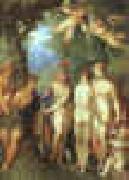 |
Balen, Hendrick von -- Click Here
|
|
Dutch, approx. 1575-1632
Hendrik van Balen
Students included Anthony Van Dyck, Frans Snyders and Gerard Seghers
|
|
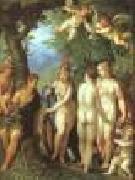 |
BALEN, Hendrick van -- Click Here
|
|
Dutch Baroque Era Painter, ca.1575-1632
Hendrik van Balen (1575 - 1632) was a Flemish painter, who was born and died in Antwerp. Van Balen studied art while traveling in Italy. He was the teacher of Anthony Van Dyck and Frans Snyders and was also a contemporary of many of the other famous Flemish artists, such as the Brueghels, Jan and Peter. |
|
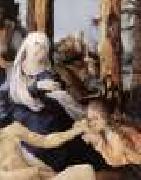 |
BALDUNG GRIEN, Hans -- Click Here
|
|
German Northern Renaissance Painter and Printmaker, ca.1484-1545 |
|
|
|
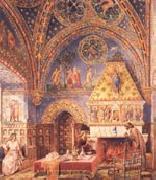 |
Axel Haig -- Click Here
|
|
Swedish etcher and architectural draughtsman , 1835-1921
Swedish printmaker, painter and architect. He studied shipbuilding in Karlskrona from 1850 to 1856. The following year he joined the shipbuilders Lawrence Hill & Co. in Glasgow, but soon left to study architecture in London, where he worked with the English architect Ewan Christian (1814-95) and with William Burges. Under the influence of Burges he became especially interested in Gothic architecture. In the late 1870s he began etching, with the intention of illustrating a book on Scotland's medieval architecture. Haig contributed illustrations to numerous English magazines, including The Architect. (For Haig's drawing of William Burges's competition entry for the Law Courts, London) In 1882 he was awarded a medal for his etchings at the Paris Salon and elected an honorary member of the Swedish Royal Academy. |
|
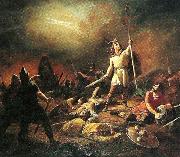 |
axel gustaf hertzberg -- Click Here
|
|
1832-1878
Axel Gustaf Hertzberg född 27 augusti 1832 i Jämtland, död 2 september 1878 i Dusseldorf , Tyskland var en svensk bildkonstnär.
Hertzberg ägnade sig först åt porträtteckning och litografi men övergick senare till oljemåleri. Han studerade vid konstakademien i Stockholm 1849-1860. Han gjorde en resa till Finland där han stannade två år. Därefter studerade han konst i Paris, och slutligen Dusseldorf.
Hertzberg blev 1867 agre vid konstakdemien i Stockholm. |
|
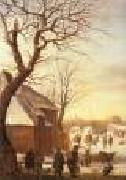 |
AVERCAMP, Hendrick -- Click Here
|
|
Dutch Baroque Era Painter, 1585-1634
1634). He was the first artist in the northern Netherlands to paint winter landscapes. Before him only a few Flemish artists, among them Pieter Bruegel I and his sons, and Jacob Grimmer, had made winter scenery the main subject of their work. Avercamp created a new genre of Dutch painting by combining the panoramic scope, bright colours and high vantage point of these Flemish models with an emphasis on anecdotal detail. |
|
|
|
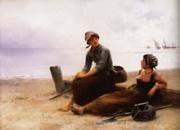 |
August Hagborg -- Click Here
|
|
1852 - 1925,Swedish painter. He studied at the Konstakademi in Stockholm (1871-5), then went to Paris in the autumn of 1875, where he lived until 1909. He began to exhibit at the Salon as early as 1876 and became one of its most industrious contributors. In 1877 he showed at the Salon his painting Waiting (1877; priv. col., see S. Strembom: Konstnersferbundets historia [History of the Federation of Artists], i (Stockholm, 1945), pl. 35), developed from a study made in Bohuslen on the west coast of Sweden. It shows a young fisherman's wife, her child on her arm, gazing out over the sea and waiting for her husband. This introduced what was to become Hagborg's favourite subject-matter: the fishing community, mostly in Normandy and Brittany. Typical elements of his paintings are young women, depicted in idealized and heroic manner, in theatrical poses, and a realistic background, usually of shallow beaches at ebb tide; in his later works, he painted in more delicate and exquisite, silvery colours. |
|
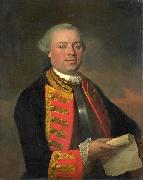 |
August Christian Hauck -- Click Here
|
|
(1742 -1801 ) - Painter |
|
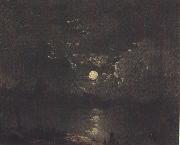 |
Attributed to henry pether -- Click Here
|
|
fl.1828-1865
|
|
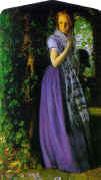 |
Arthur Hughes -- Click Here
|
|
1832-1915
British
Arthur Hughes Gallery
Hughes was born in London. His best-known paintings are April Love and The Long Engagement, both of which depict troubled couples contemplating the transience of love and beauty. They were inspired by John Everett Millais's earlier "couple" paintings but place far greater emphasis on the pathos of human inability to maintain the freshness of youthful feeling in comparison to the regenerative power of nature.
Like Millais, Hughes also painted an Ophelia and illustrated Keats's poem The Eve of St. Agnes. Hughes's version of the latter is in the form of a secular triptych, a technique he repeated for scenes from Shakespeare's As You Like It.
His works are noted for their magical, glowing colouring and delicate draughtsmanship.
Hughes was in close contact with the writer George MacDonald and illustrated some of his books as well as producing numerous illustrations for Norman MacLeod's monthly magazine, Good Words.
Hughes died in Kew Green, London, leaving about 700 known paintings and drawings, along with over 750 book illustrations. |
|
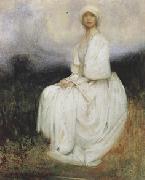 |
Arthur hacker,R.A. -- Click Here
|
|
1858-1919
was an English classicist painter. Born in London in 1858, Hacker was the son of Edward Hacker, a line engraver specialising in animal and sporting prints (who was also for many years the official Registrar of Births, Marriages and Deaths for Kentish Town in the St Pancras registration district, north London). In his art he was most known for painting religious scenes and portraits, and his art was also influenced by his extensive travels in Spain and North Africa. He studied at the Royal Academy between 1867 and 1880, and at the Atelier Bonnat in Paris. He was twice exhibited at the Royal Academy, in 1878 and 1910, and was elected an Academician in 1910. In 1894 he was the subject of a bust by Edward Onslow Ford. An original portrait by Hacker of Sir Alfred Keogh by hangs in the RAMC HQ Mess at Millbank, London. He died in London on November 12, 1919. In 1902, |
|
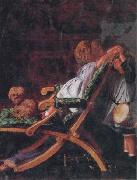 |
Arthur Boyd Houghton -- Click Here
|
|
English Painter and Illustrator , 1836-1875
His work was varied and was revered during the mid-19th century. He traveled to America and Russia, creating illustrations for The Graphic and for numerous books, including The Arabian Nights and Don Quixote. His work was strongly influenced by the Pre-Raphaelite Brotherhood. Paul Hogath wrote a biography, published in 1981 by Gordon Fraser Work by this artist is held within various public collections incluiding Tate Britain in London, as well as a number of private collections around the world. Houghton is best known for etchings but also produced a number of oil paintings, many of his wife and children. He also wrote a little poetry which was published in his lifetime. |
|
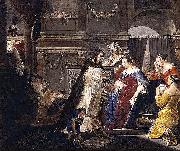 |
Arnold Houbraken -- Click Here
|
|
(28 March 1660 - 14 October 1719) was a Dutch painter and writer from Dordrecht, now remembered mainly as a biographer of artists from the Dutch Golden Age. He had ten children. His son Jacobus Houbraken (1698-1780) was an engraver of portraits and book illustrations, including books by his father. His daughter Antonina Houbraken also became an engraver for an Amsterdam publisher, and is known today for her embellishment of cityscapes and buildings with animals and people.
Houbraken was sent first to learn threadtwisting from Johannes de Haan, who introduced him to engraving. After two years he then studied art with Willem van Drielenburch, who he was with during the rampjaar, the year 1672. He then studied 9 months with Jacobus Leveck and finally, four years with Samuel van Hoogstraten. In 1685 he married Sara Sasbout, and around 1709 he moved from Dordrecht to Amsterdam. Arnold Houbraken painted mythological and religious paintings, portraits and landscapes. |
|
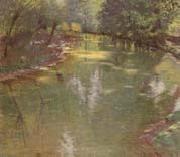 |
Antonin Hudecek -- Click Here
|
|
Czechoslovakian, 1872-1941 |
|
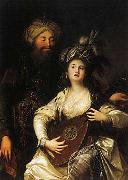 |
Anton Hickel -- Click Here
|
|
(1745 - October 30, 1798) was an 18th-century painter.
Hickel was born in Český Krumlov, Bohemia, and enrolled in the Academy of Fine Arts Vienna in Vienna, Austria in 1758. After graduation, he worked as a painter under his brother, Joseph Hickel, who was also a painter. Beginning in 1779, he served as a traveling portrait painter. He spent considerable time in Munich where he painted Charles Theodore, Elector of Bavaria, among others. He then traveled in southern Germany, Switzerland, then to Mannheim and Mainz. He moved to Switzerland in 1785, and then became the official court painter of Joseph II, Holy Roman Emperor. In 1786, he travelled to France where he painted under the patronage of Marie Antoinette and Marie-Louise, princesse de Lamballe. He died in Hamburg.
|
|
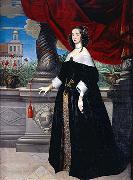 |
Anselm van Hulle -- Click Here
|
|
painted Anna Margareta Wrangel, countess of Salmis in 1648 |
|
|
|
|
|
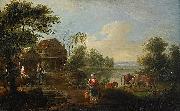 |
Anders Holm -- Click Here
|
|
(1751 -1824 ) - Painter
is a comedy writer and one of the stars and creators of the Comedy Central show Workaholics. Originally from Evanston, Illinois, Holm graduated from the University of Wisconsin - Madison and the Second City Conservatory in L.A. He, along with fellow Workaholics creators Blake Anderson, Adam DeVine and Kyle Newacheck form the sketch-comedy group, Mail Order Comedy. He also starred in a film, the Legend of Awesomest Maximus.
|
|
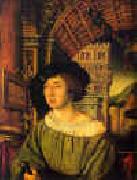 |
Ambrosius Holbein -- Click Here
|
|
1494-1519
German
Ambrosius Holbein Gallery
Ambrosius Holbein (c. 1494 ?C c. 1519) was a German and Swiss artist in painting, drawing and printmaking. He was the elder brother, by about three years, of Hans Holbein the Younger and like his brother was born in Augsburg (which today is in Bavaria, but then was a free imperial city), a center of art, culture and trade at that time. His father Hans Holbein the Elder was a pioneer and leader in the transformation of German art from the Gothic to the Renaissance style. In his studio both his sons, Ambrosius and Hans, received their first painting lessons as well as the an introduction to the crafts of the goldsmith, jeweller and printmaker.
Portrait of a Boy with Blond Hair, 1516, BaselIn 1515 Ambrosius lived in the Swiss town of Stein am Rhein, where he helped a Schaffhausen painter named Thomas Schmid with the murals in the main hall of the St George monastery. The next year saw Ambrosius, as well as his brother Hans, in Basel, where he initially worked as a journeyman in Hans Herbster??s studio. In 1517 he was enrolled in a register of the Basel painters' guild and in 1518 he was naturalized as a citizen there.
The Portrait of a Boy with Blond Hair and its companion, the Portrait of a Boy with Brown Hair, are among Ambrosius?? best works of this period. Both are nowadays in the Basel Kunstmuseum.
Ambrosius Holbein ranks among the most important of Basel??s illustrators and prominent „small formats?? artists. |
|
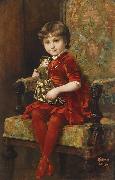 |
Alois Hans Schram -- Click Here
|
|
Alois Hans Schram
(1864 - 1919)
Alois Hans Schram was born in Vienna on August 20th. He was a painter and sculptor of historical subjects, figures, nudes, portraits, scenes with figures, genre scenes, local scenes, interiors with figures, landscapes with figures, urban landscapes, waterscapes and seascapes. |
|
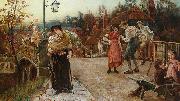 |
Alice Mary Havers -- Click Here
|
|
(1850-1890) - Painter |
|
|
|
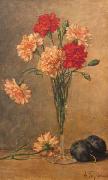 |
Alfred Hirv -- Click Here
|
|
(born March 26, 1880 in Pechory - died May 26, 1918 in Pskov) was an Estonian painter, known especially for his still lifes. For a time he studied with Julius von Klever in Saint Petersburg; further studies took him to Rome and Munich, where he studied at the school of Anton Ažbe. His paintings are reminiscent of the style of the Dutch Golden Age. Works by Hirv can be found in the Estonian Art Museum.
|
|
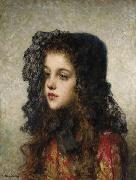 |
Alexei Harlamov -- Click Here
|
|
(or Alexej Harlamoff - Alexej Charlamoff) (1840-1925) was a Russian painter.
Harlamoff paintings are signed "Harlamoff", which may be a translation he learned while studying in Paris. This does not translate into the Russian language from English. |
|
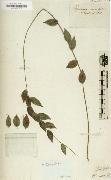 |
Alexander von Humboldt -- Click Here
|
|
Berlin 1769-1859 Berlin,was a German naturalist and explorer, and the younger brother of the Prussian minister, philosopher, and linguist Wilhelm von Humboldt (1767-1835). Humboldt's quantitative work on botanical geography was foundational to the field of biogeography. Between 1799 and 1804, Humboldt travelled to Latin America, exploring and describing it from a scientific point of view for the first time. His description of the journey was written up and published in an enormous set of volumes over 21 years. He was one of the first to propose that the lands bordering the Atlantic were once joined (South America and Africa in particular). Later, his five-volume work Kosmos (1845) attempted to unify the various branches of scientific knowledge. |
|
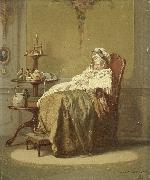 |
Alexander Hugo Bakker Korff -- Click Here
|
|
painted An Afternoon Nap in 1866 |
|
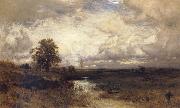 |
Alexander Helwig Wyant -- Click Here
|
|
American Tonalist Painter, 1836-1892,American painter. He began as an itinerant painter of topographical landscapes along the banks of the Ohio River c. 1854, influenced by such landscape artists as Worthington Whittredge and George Inness. In 1863-4 Wyant moved to New York, where he was impressed by the paintings of the Norwegian artist Hans Gude in the Desseldorf Gallery. This led him to work with Gude in Karlsruhe, Germany, in 1865. On his way both there and back, he studied paintings by Constable and used a more painterly technique especially for views of Ireland. |
|
|
|
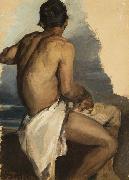 |
Albert Hertel -- Click Here
|
|
painted Mannlicher Ruckenakt in 1864 |
|
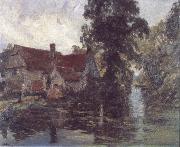 |
Albert Henry Fullwood -- Click Here
|
|
British, 1864-1930 |
|
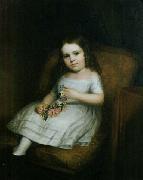 |
Albert Gallatin Hoit -- Click Here
|
|
Albert Gallatin Hoit (December 13, 1809 - December 18, 1856) was an American painter who lived in Boston, Massachusetts. He painted portraits of William Henry Harrison, Daniel Webster and Brenton Halliburton.
Hoit was born in Sandwich, New Hampshire, December 13, 1809, to Gen. Daniel Hoit and Sally Flanders. Siblings included William Henry Hoit. Hoit graduated from Dartmouth College in 1829. He married Susan Hanson in 1838; children included Anna M. Hoit.
Hoit "devoted his life to portrait painting, first at Portland, Maine, in 1831, and then in Bangor and Belfast, Maine, and St. John's, N.B. until Boston, Mass., became his permanent home in 1839." He also travelled in Europe, "Oct. 1842 to July 1844, ... enjoying the galleries of art in Italy, Paris, and London." He created portraits of Pietro Bachi, Johanna Robinson Hazen, J. Eames, and others. He painted a portrait of Daniel Webster "for Paran Stevens, which hung for years in the Revere House, Boston, and now belongs to the Union League Club, New York."
He was affiliated with the Boston Artists' Association; and exhibited at the gallery of the New England Art Union in the 1850s. In 1848, he kept a studio on Tremont Row in Boston, and lived in Roxbury. By 1852, he'd moved his studio to Washington Street.
Hoit died in Jamaica Plain, December 18, 1856, at age 47.
|
|
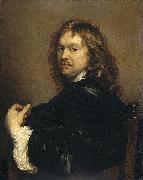 |
Adriaen Hanneman -- Click Here
|
|
(c. 1603 - buried 11 July 1671) was a Dutch Golden Age painter best-known today for his portraits of the exiled British royal court. His style was strongly influenced by his contemporary, Anthony Van Dyck.
|
|
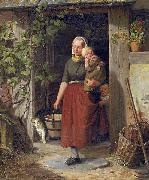 |
Adolph Heinrich Richter -- Click Here
|
|
painted A young wine grower and her children in |
|
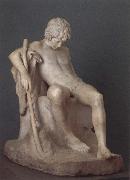 |
Adolf von Hildebrand -- Click Here
|
|
1847 Marburg-1921 Munich, He was a sculptor, the son of Marburg economics professor Bruno Hildebrand. He was the author of Das Problem der Form in der Bildenden Kunst ("The Problem of Form in Painting and Sculpture"). From 1873 he lived in Florence in San Francesco, a secularized sixteenth-century monastery. In 1877 he married Irene Schäuffelen. He spent significant time in Munich after 1889 executing a monumental fountain there, the Wittelsbacher Brunnen. He is known for five monumental urban fountains. He was ennobled by the King of Bavaria in 1904, He was the father of the painter Eva, Elizabeth, sculptor Irene Georgii-Hildebrand, Sylvie, Bertele, and Catholic theologian Dietrich von Hildebrand. |
|
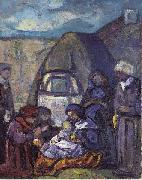 |
Adolf Holzel -- Click Here
|
|
(13 May 1853 - 17 October 1934) was a German artist/painter. His style developed from Impressionism to expressive modernism.
He was born in Olomouc in Moravia, the son of the publisher Eduard Hölzel. In 1871 his family moved to Vienna, and from 1872 he studied painting at the Vienna Academy. He continued his studies in Munich at the Kunstakademie beginning in 1876. There he became acquainted with the painter Fritz von Uhde and painted in a style influenced by Impressionism.
From 1888 to 1905 he worked in Dachau, where there was an artists' colony. Already during his time in Dachau his work began moving toward abstraction, reflecting his interest in such principles as the golden section and Goethe's Theory of Colors. He taught at the Stuttgart Academy, and paintedefour years before Wassily Kandinskyean abstract painting (Composition in Red, 1905). Among his students the so-called "Hölzel circle" developed, including Oskar Schlemmer, Willi Baumeister, Max Ackermann and Johannes Itten. In 1919 Adolf Hölzel left the Stuttgart Academy and went into retirement. He died in Stuttgart in 1934.
|
|
|
|
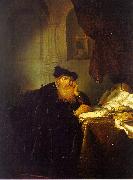 |
Abraham van der Hecken -- Click Here
|
|
Dutch Baroque Era Painter, active 1635-1655 |
|
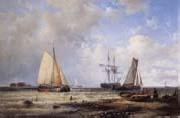 |
Abraham Hulk -- Click Here
|
|
1813-1897 Born in London, the senior member and best known of a family of painters, Abraham Hulk studied in Holland at the Amsterdam Academy under portrait painter Jean Augustin Daiwaille. |
|
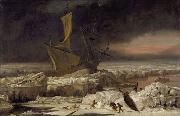 |
Abraham Hondius -- Click Here
|
|
(1625 - 1691) was a Dutch Golden Age painter known his depictions of animals. He was the son of a city stonemason, Daniel Abramsz de Hondt.
Hondius was born in Rotterdam and trained under Pieter de Bloot ( 1601 - 1658) and Cornelis Saftleven.He lived in Rotterdam until 1659 and moved then to Amsterdam. He moved to London] in 1666, where he spent the rest of his life. Hondius combined throughout his career several stylistic influences and struggled to develop a style of his own. He however specialised somehow in animal pieces: more than two-thirds of his paintings, etchings and drawings are hunting scenes, animals fighting and animal studies. He also executed landscapes, genre and religious scenes.
Hondius most likely moved to London] (where he later died) in 1666 where he spent the rest of his life. He painted views of London such as The Frost Fair on the Thames at Temple Stairs and London Bridge. His last known work is "Ape and Cat Fighting over Dead Poultry," dated 1690.
|
|
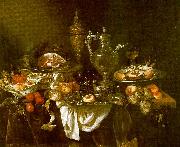 |
Abraham Hendrickz van Beyeren -- Click Here
|
|
1621-1690
Dutch
Abraham Hendrickz van Beyeren Location |
|
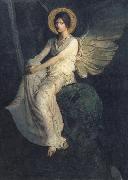 |
Abbott Handerson Thayer -- Click Here
|
|
American Painter, 1849-1921
American painter and naturalist. He spent his youth in rural New England, where his earliest paintings were wildlife subjects, reflecting his interest in hunting and fishing. While in his teens Thayer achieved some success doing portraits of family pets, which he continued after a move to New York. He attended classes at the Brooklyn Art School and National Academy of Design, but in 1875 he settled in Paris, studying under Henri Lehmann and Jean-L?on G?r?me at the Ecole des Beaux-Arts. While abroad he produced landscapes in the Barbizon style and genre scenes, but on his return to New York in 1879 |
|
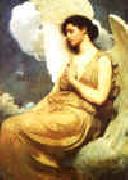 |
Abbot H Thayer -- Click Here
|
|
1849-1921
Abbot H Thayer Galleries
Abbott Handerson Thayer (August 12, 1849 ?C May 29, 1921) was an American artist, naturalist and teacher. As a painter of portraits, figures, animals and landscapes, he enjoyed a certain prominence during his lifetime, as shown by the fact that his paintings are in the most important U.S. art collections. In the last third of his life, he worked together with his son, Gerald Handerson Thayer, on a major book about protective coloration in nature, titled Concealing Coloration in the Animal Kingdom: An Exposition of the Laws of Disguise Through Color and Pattern; Being a Summary of Abbott H. Thayer??s Disclosures. First published by Macmillan in 1909, then reissued in 1918, it had a widespread impact on the use of military camouflage during World War I. He also influenced American art through his efforts as a teacher, taking on apprentices in his New Hampshire studio. |
|
|
|
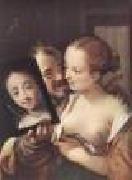 |
AACHEN, Hans von -- Click Here
|
|
German Mannerist Painter, 1552-1615
(b Cologne, 1552; d Prague, 4 March 1615). German painter and draughtsman, active also in Italy and Bohemia. One of the foremost painters of the circle gathered at the Prague court of Emperor Rudolf II. |
|
|
|
|
| | |
|
|
|
|